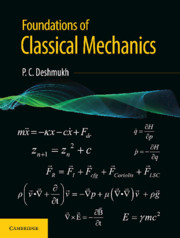Book contents
- Frontmatter
- Dedication
- Contents
- List of Figures
- List of Tables
- Foreword
- Preface
- Introduction
- 1 Laws of Mechanics and Symmetry Principles
- 2 Mathematical Preliminaries
- 3 Real Effects of Pseudo-forces: Description of Motion in Accelerated Frame of Reference
- 4 Small Oscillations and Wave Motion
- 5 Damped and Driven Oscillations; Resonances
- 6 The Variational Principle
- 7 Angular Momentum and Rigid Body Dynamics
- 8 The Gravitational Interaction in Newtonian Mechanics
- 9 Complex Behavior of Simple System
- 10 Gradient Operator, Methods of Fluid Mechanics, and Electrodynamics
- 11 Rudiments of Fluid Mechanics
- 12 Basic Principles of Electrodynamics
- 13 Introduction to the Special Theory of Relativity
- 14 A Glimpse of the General Theory of Relativity
- Index
14 - A Glimpse of the General Theory of Relativity
Published online by Cambridge University Press: 06 November 2019
- Frontmatter
- Dedication
- Contents
- List of Figures
- List of Tables
- Foreword
- Preface
- Introduction
- 1 Laws of Mechanics and Symmetry Principles
- 2 Mathematical Preliminaries
- 3 Real Effects of Pseudo-forces: Description of Motion in Accelerated Frame of Reference
- 4 Small Oscillations and Wave Motion
- 5 Damped and Driven Oscillations; Resonances
- 6 The Variational Principle
- 7 Angular Momentum and Rigid Body Dynamics
- 8 The Gravitational Interaction in Newtonian Mechanics
- 9 Complex Behavior of Simple System
- 10 Gradient Operator, Methods of Fluid Mechanics, and Electrodynamics
- 11 Rudiments of Fluid Mechanics
- 12 Basic Principles of Electrodynamics
- 13 Introduction to the Special Theory of Relativity
- 14 A Glimpse of the General Theory of Relativity
- Index
Summary
If at first the idea is not absurd, then there is no hope for it.
—Albert EinsteinGEOMETRY OF THE SPACE–TIME CONTINUUM
The gravitational interaction is the earliest physical interaction that humans have registered. The earliest speculations about just what is the nature of gravity were not merely wrong, but absurdly far-fetched. Ancient philosophers even conjectured that the earth is the natural abode of things, and objects fall down when they are dropped just as horses return to their stables. Various theories of gravity were proposed, and the one that lasted much is that developed by Isaac Newton in the seventeenth century. Newton's work on gravity integrated the dynamics of astronomical objects with that of falling apples or coconuts, determined by one common principle (Chapter 8). We celebrate this principle as Newton's one-over-distance-square law of gravity.
An amazing consequence of the constancy of the speed of light in all inertial frames of reference that we studied in the previous chapter is the time-dilation and Lorentz contraction (also called the length contraction). The phenomenon that is responsible for the traveling twin to age slower than the home-bound twin holds for any and every object in motion. We have already noted that this happens to decaying muons. Essentially, the faster you move through space, the slower you move through time, in the spacetime continuum.
We all enjoy raising our speed, covering more distance in lesser, and lesser, time. Let us therefore ask, to what extent can we speed up an object? We ask if there is a natural limit for this. If you look back into the relations for time-dilation and the length contraction in the previous chapter, you will recognize that if v = c, the effect of time-dilation would be such that the traveling twin will simply stop ageing. Time would stop for her; time freezes. The effect of Lorentz contraction would also be total; she would think that the rest of the universe has spatially contracted to a point. She is therefore already everywhere (along the line of motion). All of these dramatic aftermaths are because of a simple fundamental property that the speed of the headlight of a car coming toward you at a velocity v is no different from that of the tail light of another that is receding away from you.
- Type
- Chapter
- Information
- Foundations of Classical Mechanics , pp. 523 - 548Publisher: Cambridge University PressPrint publication year: 2019



